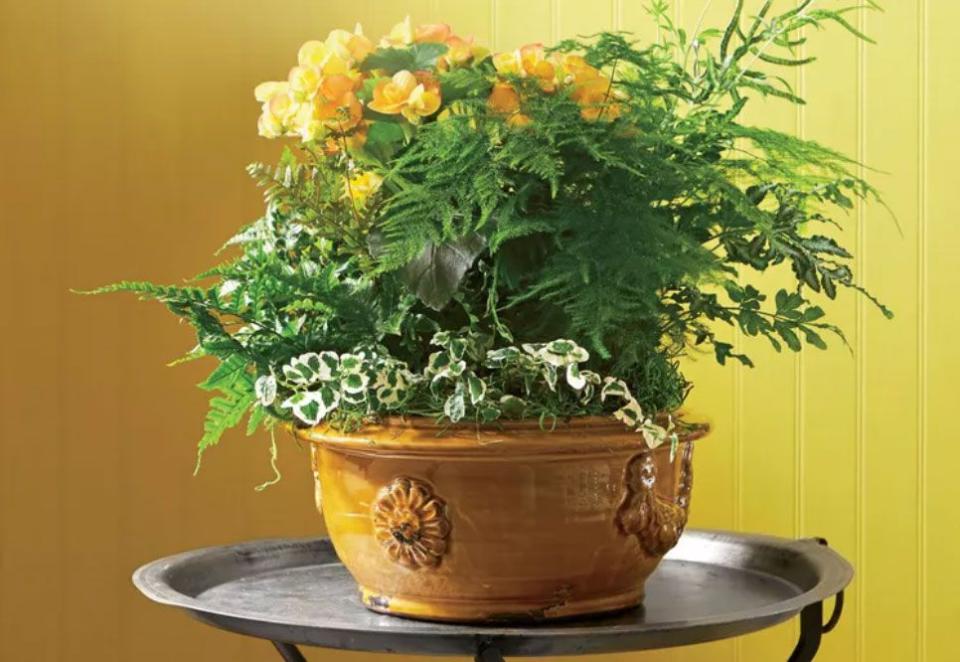What Exactly Is A Cachepot? And Why Southerners Love Them
Nothing fancies up a room quite like a cachepot.

Hector Sanchez
In the South, we do tend to enjoy fancying up everyday things, whether that means putting the deviled eggs on your heirloom china platter (preferably Blue Willow), tissue box in a monogrammed linen cover, or candy in a polished silver dish. “Making it pretty,” as many a Southern grandma would say. These decorative items aren’t necessarily meant for convenience or to have a specific function, but rather to offer a touch of put-togetherness on an otherwise not-so-dressy thing.
Turns out, there’s also something that Southerners prefer to use for indoor plants for “making it pretty” purposes, and it’s called a cachepot. This traditional decorative planter isn’t your basic pot, and that’s precisely why Southerners love it.
What Is a Cachepot?
Put simply, a cachepot is a plant pot without a drainage hole in the bottom. It’s derived from the French language, meaning literally “hide a pot” and pronounced like cash-poe. In Victorian times, cachepots became a popular way to cycle plants in and out of the home more easily. They’re meant to be a more aesthetically pleasing option for displaying a potted plant indoors other than the generally plain or outdoorsy pots that they grow in—and they are not to be confused with a vase, which is used to display cut flowers. You simply place the more functional potted plant (usually in terracotta or plastic) into the cachepot, which conceals it, and you are still able to remove it for watering and place it back in the cachepot after draining for display.
Why Southerners Love Cachepots
As avid hosts and homemakers, Southerners have always loved to use a cachepot as it was intended, as a means to conceal a potting container, and cachepots also have become a decorative element independently in many Southern homes, thanks to their inherent charm. Cachepots can be found in many forms, but it’s not uncommon to find a passed-down cachepot in a classic china pattern, which serves as a design moment all on its own.
Additionally, since the South is well known for its botanical prowess and ability to grow so many different types of plants and flowers, many Southerners have quite the “green thumb,” making it even more appealing to fill your home inside and out with beautiful potted plants.
Moreover, it’s a well-known hosting secret that, in the case of being a last-minute host or before any event at your home, you can easily run to the garden store and grab already-blooming plants to hastily place in a cachepot whenever needed. No one’s the wiser!
Related: 9 Decorating Details That Prove Your House Is Southern
How To Take Care of a Cachepot Plant
When using a cachepot, it is important to remember that since there is no drainage hole in cachepots, it is not ideal to water the plant while it is in the cachepot. If there is leftover standing water in the soil, over time the roots can rot and the plant will die. Therefore, think of cachepots as more of a way to just display your healthy plants. Make sure to remove the interior potted plant to water as necessary, allow it to drain, and then you can place it back into the cachepot.
Other Uses For a Cachepot
If you’re not exactly the gardening type, a cachepot can add a decorative element to many surfaces, even sans a plant. It can be used as an umbrella stand, shelf accent, mantle decoration, or wastebasket in a powder bath. Also, keep in mind you can bring these vessels to your favorite garden shop to determine what fits best, or even place a faux plant in the cachepot for a more elegant look. No matter where you place a cachepot, the space is instantly upgraded.
Frequently Asked Questions
What is a cachepot used for?
A cachepot is a decorative planter with no drainage hole that is used as a means to conceal a basic or less-appealing potting container.
How do you pronounce cachepot?
In French, cachepot translates to "hide the pot" and is pronounced like cash-poe. Some prefer to pronounce it colloquially as cash-pot.
How do you water a cachepot plant?
Unless it is a plant that requires very little water, you are required to take out the interior plant (in its original pot) and water it separately from the cachepot. Then, you can return the plant to the cachepot once all the excess water has drained.
For more Southern Living news, make sure to sign up for our newsletter!
Read the original article on Southern Living.

